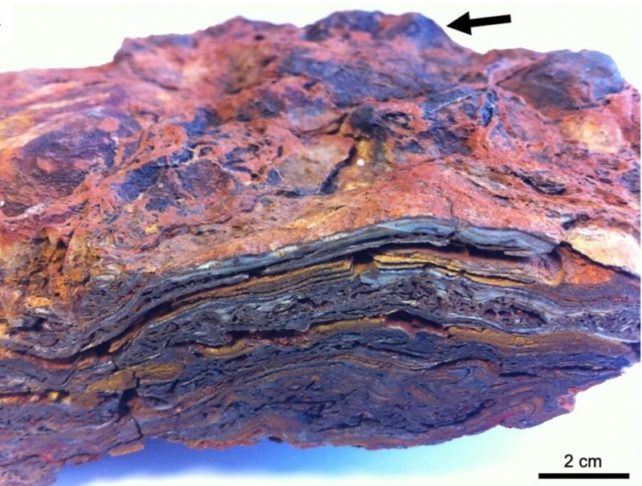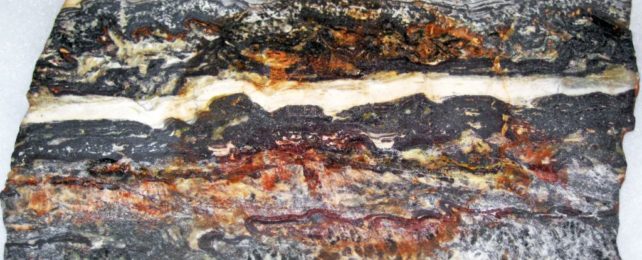Tracking down the oldest traces of life on Earth isn't easy. Smoosh a bunch of microbes between layers of rock and let them ripen for billions of years; what you end up with is going to resemble rock more than an ancient life form.
It takes a real eye to then distinguish one from the other, and even then debates are rarely settled.
Take a set of 3.48 billion-year-old rock formations from Western Australia for example. Speculated to be the fossilized remains of microbial metropolises known as stromatolites, ruling out the possibility they are purely geological is easier said than done.
Now a new analysis by an international team of researchers provides strong evidence that these formations really are biological in origin, and not the result of non-living processes.
"If an archaeologist discovered the foundations of a ruined city, they would nonetheless know it was built by people because it would bear all the hallmarks of being built by people – doorways and roads and bricks," explains paleontologist Keyron Hickman-Lewis of the Natural History Museum in the UK.
"In very much the same way, there are numerous structural elements integral to stromatolites that allow us to identify their processes of formation and decode their origins. We can almost be archaeologists in deep time."
Stromatolites dating back billions of years are found scattered around the world. They consist of laminated, or finely layered, rock that could be produced either by mineralized layers of microbial matting or by non-living chemical reactions between the rock and its environment.
The job of the paleontologist is to try to work out which is which – not always easy, as seen in 3.7 billion-year-old stromatolite-like layers in Greenland, which were first declared the world's oldest fossils and then found to be just plain old rocks.
But the identification of the oldest fossils on this marvelous, 4.54 billion–year-old blue marble of ours isn't just an exercise in breaking records. It's of deep interest to all of us when, and where, life first developed on Earth – the ancient origins of humanity, and all the life that thrives today.
Currently, the 3.43 billion-year-old stromatolites from another site in Western Australia, the Strelley Pool formation, are the oldest widely accepted traces of life on Earth. Now Hickman-Lewis and his colleagues have subjected 3.48 billion-year-old stromatolites from the Western Australian Dresser Formation to new and rigorous study.
They used multiple techniques to examine the two- and three-dimensional microstructures present in the Dresser stromatolites, including optical microscopy, Raman spectroscopy, scanning electron microscopy, laser ablation inductively coupled plasma-mass spectrometry (ICP-MS), and laboratory and synchrotron computed tomography.
None of these tests revealed microfossils or organic materials, but they did show structures and characteristics consistent with a biological origin.

Once upon a time, the team concluded, the stromatolites were photosynthetic microbial mats thriving on the floor of a shallow marine lagoon. As sediment settled on the mats the microbes pushed upwards, away from the sediment and towards the sunlight to form dome structures resembling the cups in an egg carton. These shapes were what were preserved in the fossil formation.
The team also observed pillar-like "palisade" formations, consistent with patterns in rock known to be created by the growth of microbes. Like the dome structures, these were probably the result of organisms moving towards sunlight, the researchers claimed. Small voids in the rock are consistent with degassing or desiccation of decaying organic material.
Taken together, these clues constitute strong evidence in favor of the biological origin of these ancient layers of rock, making them the oldest evidence of life on Earth – which has implications for the search for life elsewhere.
When the Dresser Formation was a shallow lagoon, the Jezero crater on Mars was likely a very similar environment. So it's possible that life was emerging on Mars at the same time, a Martian period known as the Noachian. Identifying fossilized life of a similar age and environment here on Earth could help us identify such fossils on Mars, if the Perseverance rover finds any.
"Occurring within the stratigraphically lowermost sedimentary horizons of the Dresser Formation, these stromatolites are the oldest direct evidence for life on Earth," the researchers write in their paper.
"Their paleodepositional setting, polyextremophilic biology, and taphonomy make them ideal analog biosignatures for Mars, reflecting the type of morphological fossils one might expect to encounter in altered Noachian carbonates."
The research has been published in Geology.
